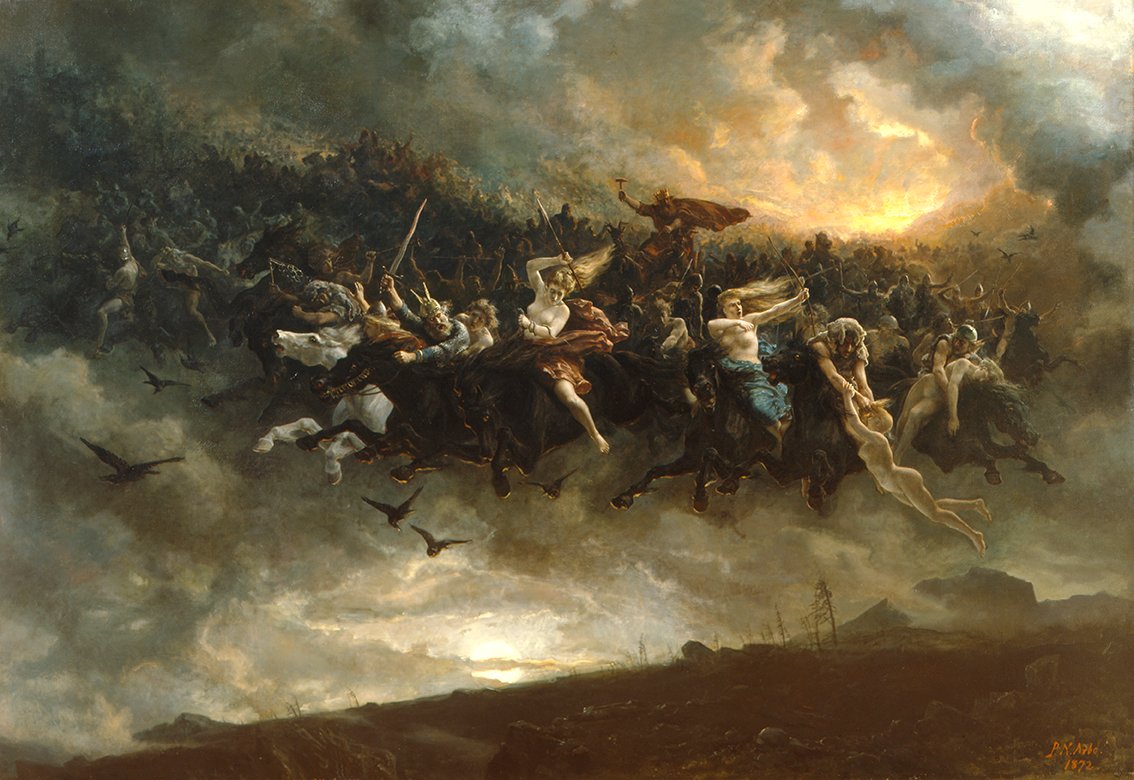
Other feminine beings who exercised control over the fates of men and were closely related to the Norns, were the Valkyries. Victory lay in their government, and mortality in battle; Odin sent them forth to “choose the slain” or the heroes who were doomed to fall.1 They were therefore also called the Maidens of Odin. They were beautiful young girls; armed and fully panoplied, they rode through the air and over the waters, to the ends of the world. At home in Valhalla they served as cupbearers to the Æsir and Heroes in the halls of Odin. There were two classes of Valkyries: an original order, the celestial Valkyries; and another order, half mortal and half divine, who lived for a time among men as mortals but who later came to Odin in Valhalla, evidently a sort of feminine counterpart to the Heroes. The number of the celestial Valkyries is variously computed, as nine or as nine times nine; they were frequently imagined as riding about in three groups. Those most commonly mentioned were Gondul, Skogul (also called Geir-Skogul, or Spear-Skogul), Lokk, Rist, Mist, Hild, and others. Skuld1 was also counted among the Valkyries. Besides these, there were other Valkyries who created dissension among the Heroes and who were employed only in the most menial tasks.
Valkyries, Norns, Familiar Spirits, Attendant Spirits, and occasionally even certain of the goddesses, notably Freyja, were known by the general designation of Disir. Dís (plural dísir) was no doubt originally a term used to denote a distinct group of gods. Worship of them consisted of a special kind of sacrifice (dísablót), doubtless a more intimate cult, participated in only by women; the Disir were supposed to have particular concern for the good of the home and the family, and in so far were not noticeably different from the Attendant Spirits of a family (kynfylgjur, spádísir), which have been discussed above. From their number, however, proceeded a goddess who was to become the centre of a more general cult; and it must have been this goddess — perhaps Vanadís, Freyja — who was worshipped in Disarsal near Uppsala. In connection with the annual sacrifice to the Disir at Uppsala were held also a court assembly (dísaþing) and a market; until very recent times the market-fair of Uppsala at Candlemass, early in February, was commonly called “Distingen,” that is, the Disir court.
 Bilingual Vietnamese Fairy Tales
Bilingual Vietnamese Fairy Tales
 Vietnamese Fairy Tales Collection
Vietnamese Fairy Tales Collection
 Shan Hai Jing
Shan Hai Jing
 The 72 Spirits of Solomon
The 72 Spirits of Solomon
Comments
Post a Comment